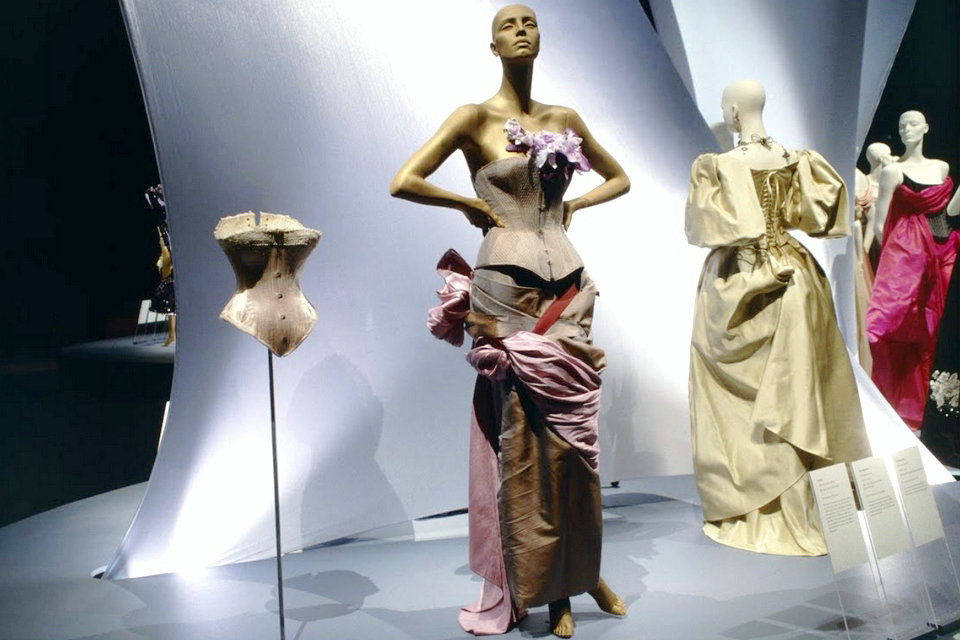Vivienne Westwood: corset that blends fashion and fine art, 360° Video, Victoria and Albert Museum


The shape of fashion, See the corset that blends fashion and fine art. Once a piece of underwear, see how the corset has inspired Vivienne Westwood to bring the worlds of fashion and art together in one place. Explore the garment in virtual reality and discover more about the stories behind the clothes.
The ‘Boucher’ corset, preserved in the Victoria and Albert Museum, embodies a fascinating blend between fashion and fine art and underlines Vivienne Westwood’s impact as a fashion designer. Discover how Westwood transformed this bespoke underwear into a coveted top garment of today.
The Corset: Fashioning the Body
The corset is one of the most controversial items of clothing in the history of fashion. Worn by women throughout the western world from the late Renaissance into the 20th century, the corset was an essential element of fashionable dress. Dress reformers argued that women’s bodies were “deformed” by fashion.
By emphasizing the sexually dimorphic curves of a woman’s body, the corset functioned as a symbol of female beauty. Women with slender waists look younger and more feminine, because the waist-hip differential in young women tends to be 0.7 (waist seven-tenths as large as hips), in contrast to men’s ratio of 0.85 or 0.9. After menopause, as fertility and estrogen levels decline, women’s bodies approach the male ratio.
With the fashion revolution of the early 20th century, most women stopped wearing boned corsets and adopted elasticized foundation garments. Why did women abandon corsets? Historical evidence suggests that changes in fashion were directly associated with changing attitudes toward the body. The corset did not so much disappear as become transformed. First it evolved into the girdle and brassiere. Then, more radically, the corset became internalized through diet, exercise, and now also plastic surgery. The hard body replaced the boned corset.
The Late 20th Century
In the late 20th century, street styles such as punk and the new romanticism brought the corset back into fashion—as outerwear. The reappearance of the corset reveals how the meaning of clothing is constantly being redefined. The corset certainly no longer signifies “respectability.” It has, instead, a range of meanings, from the seductively feminine to the fierce femme fatale.
In the wake of the sexual liberation movement, young women associated with London’s punk and goth subcultures in the early 1970s began to reappropriate the corset as a symbol of rebellion. Corsets were also increasingly adopted by young men who wore the garment to clubs that welcomed the expression of “radical” or “transgressive” sexuality.
Long disparaged as a symbol of female oppression, the corset was reconceived as a symbol of female sexual empowerment by Madonna, aided and abetted by Jean Paul Gaultier.
Vivienne Westwood
Dame Vivienne Isabel Westwood is a British fashion designer and businesswoman, largely responsible for bringing modern punk and new wave fashions into the mainstream. She was inspired by the shock-value of punk—”seeing if one could put a spoke in the system”.
Adopted by avant-garde fashion designers, such as Vivienne Westwood, herself a punk in the late 1970s, the corset began a second life in fashion.
Vivienne Westwood’s revival of the corset may be one of her most important contributions to 20th century fashion. Many other designers have also been inspired by the corset, and it seemed to come back into fashion every two or three years — 1992, 1994, 1997, 2000, and 2001.
Most designers tend to focus on very feminine or beautiful corsets, but there are also a variety of “exotic” corsets. The Dinka “corset” from East Africa (center) was the inspiration for this Dior gown.
Another type of contemporary corset treats the body not as an idealized female form, or a surrogate for the hard body, but rather as something deeply vulnerable, even wounded.
Especially within the world of fashion, cultural signs, like the corset, have no fixed meaning. Throughout human history, people in all cultures have demonstrated an urge to “dress” or “fashion” their bodies in ways that respond to particular sociocultural ideals of beauty, eroticism, status, conformity, and other powerful forces. As we move through the 21st century, the corset shows no signs of disappearing.
Victoria and Albert Museum
The Victoria and Albert Museum (often abbreviated as the V&A) in London is the world’s largest museum of applied and decorative arts and design, as well as sculpture, housing a permanent collection of over 2.27 million objects.[4] It was founded in 1852 and named after Queen Victoria and Prince Albert.
As the world’s leading museum of art and design, the V&A enriches people’s lives by promoting the practice of design and increasing knowledge, understanding and enjoyment of the designed world.